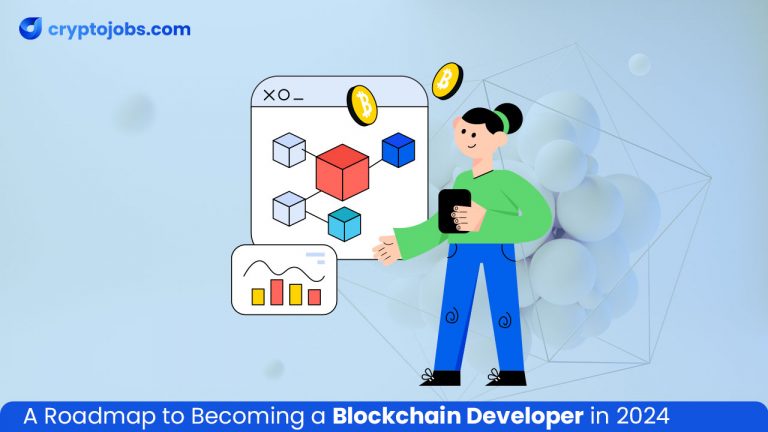
A Roadmap to Becoming a Blockchain Developer in 2024
- cryptojobs.com
- March 14, 2024
- All Posts, Career Guide
- blockchain developer
- 0 Comments
The Economist designated blockchain technology as “The Trust Machine” in 2015. Despite this many still have difficulty understanding it, even those who have a strong grasp of technological concepts. Becoming a blockchain developer may not be easy but it is worth it. Beginners need to follow a set path to become a blockchain developer and excel at this position.
In this article, we demystify blockchain technology and development. It also contains a clear roadmap to becoming a blockchain developer. Whether you have a technical background or not, this article aims to guide people with all levels of expertise. Let’s get started!
Key Concepts
Blocks: The fundamental units of blockchain that contain data and are linked together using cryptography.
Consensus mechanisms: The protocols that ensure the agreement on the state of a blockchain. Different consensus mechanisms have different ways of validating transactions.
Smart contracts: The automated contracts that automatically execute themselves when the terms of an agreement are fulfilled.
What is Blockchain?
Blockchain is a type of digital database used to store and organize information. Traditionally, databases organized information into rows and columns that formed tables. These tables made it easier for computers to recognize and interpret the information. With blockchain, however, the information is encrypted and stored in the form of clusters or blocks. Each of these blocks has a limited storage capacity. Once it is reached, the block closes and links to the one preceding it via cryptography.
An unchangeable time stamp is also created when the blocks link together. This stamp verifies the accuracy of sensitive information inside the blocks. The chain of information containing blocks is called a blockchain. The blockchains are then distributed to the people involved so that everyone receives a copy. Unlike traditional databases which are controlled by a central authority, blockchains are managed by the people directly involved. They are designed to resist data modification, providing a reliable record.
What Does a Blockchain Developer Do?
A blockchain developer builds, maintains, and designs blockchain applications and systems. Using the technology’s unique features, they create opportunities and solve problems for their clients. There are two types of blockchain developers:
- Core Blockchain Developer: Core blockchain developers build and maintain the foundational structure of blockchain systems. They develop security patterns, design the consensus mechanisms, and oversee the network as a whole.
- Blockchain Software Developer: Blockchain software developers build applications on the foundational architecture that the core blockchain developer has already constructed. Their job involves front-end development, design, back-end development, and maintenance.
Steps to Become a Blockchain Developer
Most blockchain developers start their career journey with a degree in computer science or information technology. If you lack a technical background, you are likely to learn coding and programming languages first. Once you’ve acquired foundational computer programming skills, such as HTML, CSS, JavaScript, etc., you’ll move on to specialized blockchain programming.
Here are some steps to take on your way toward becoming a proficient blockchain developer:
Grasp the Basics
The blockchain development process is full of intricate details, so it is essential that you grasp the fundamentals first. Start by learning how blockchain works, the essentials of its decentralized nature, and the cryptographic principles that govern it. You can use resources like blockchain documentation, online certification programs, and tutorials. They can help you build a solid understanding so you can move forward.
Learn Programming Languages
Proficiency in programming languages is a must for blockchain developer jobs. Start by learning basic programming languages, such as HTML and CSS. Once you feel confident, progress to the ones relevant to blockchain. The most commonly used languages in blockchain development are Solidity, Python, JavaScript, and Go. Solidity, in particular, is important because it is used for developing smart contracts, a fundamental aspect of blockchain development.
Explore Blockchain Frameworks and Platforms
The next step is to familiarize yourself with blockchain frameworks and platforms. The most popular ones include Ethereum, Hyperledger, Binance Smart Chain, and Polkadot. Each of these boasts unique features that prove to be useful in various cases. Gain hands-on experience with each of these to increase your knowledge of blockchain development.
Learn Smart Contract Development
Blockchain developers are also responsible for developing smart contracts. These are self-executing contracts with terms pre-written into the code. Learn about the different stages of a smart contract life cycle. These include development, auditing, deployment, and execution.
Explore Decentralized Applications (DApps)
The next step is to explore DApp development platforms and start building apps. Focus on creating user-friendly interfaces, smart contracts integration, and blockchain interaction. Contribute to open-source projects and collaborate with other blockchain developers to perfect your craft.
Understand Security and Consensus Mechanisms
A blockchain is secured by reliable consensus mechanisms. These are algorithm-powered protocols that determine the state of a blockchain. Some examples include Proof of Stake (PoS), Delegated Proof of Stake (DPoS), and Proof of Work (PoW). It is essential that you learn about these. You should also learn about the best security practices to secure your blockchain projects from vulnerabilities and malicious attacks.
Compile a Portfolio
When you have worked on enough smart contracts, DApps, and other blockchain projects, assemble a portfolio to showcase them. When it comes to blockchain developer jobs, recruiters prefer candidates with practical experience, so a well-crafted portfolio is a way to stand out.
Keep up With the Industry Trends
The blockchain ecosystem is dynamic. New advancements and developments are continuously introduced in this space. That’s why you have to keep up with the latest news and updates. You can join online communities, forums, or networks focused on blockchain. Conferences and webinars are also a great resource to connect with fellow developers. Collaborate in projects and share your insights to become an expert yourself.
Conclusion
Becoming a blockchain developer requires dedication and effort. If you want to succeed you should have a passion for innovation and continuous learning. Follow the steps we have outlined above and find your footing in this rapidly evolving field. The journey may be tough, but your adaptability and proactive approach will lead you on.
Finding Web3 jobs in the competitive web3 space can be stress-free with cryptojobs.com, as top Web3 and crypto companies trust the platform for hiring the best talent. Start your job search today and find a position that matches your skillset.




